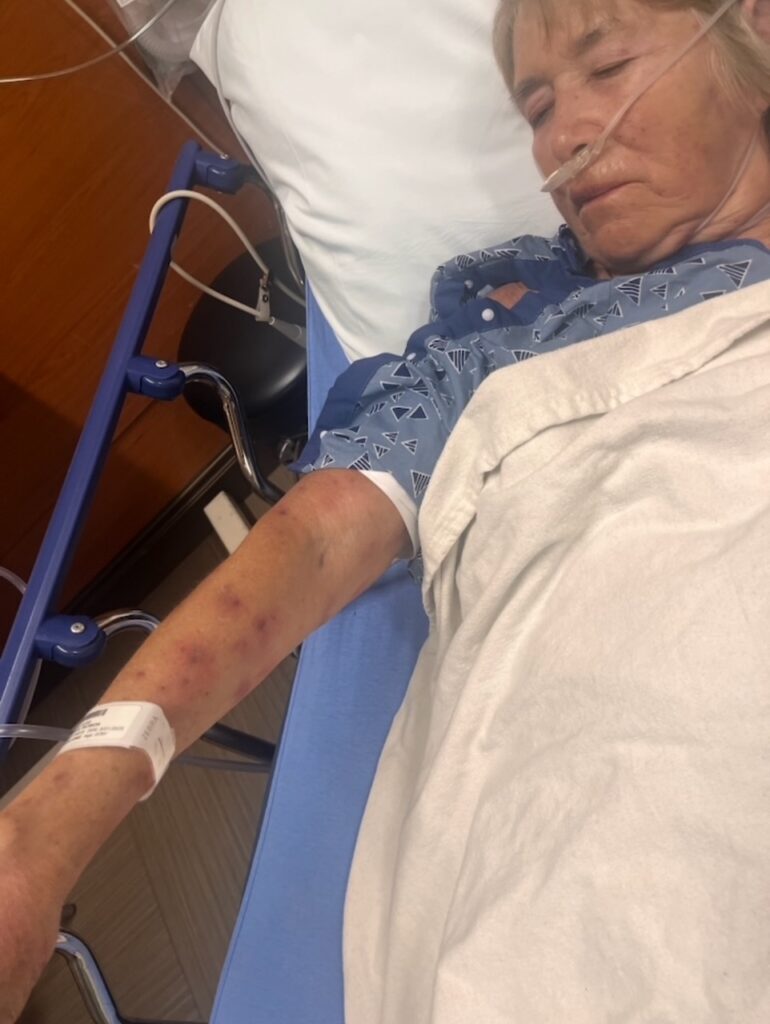
Three Chandler, Arizona women invited Patty Schlaeger, a Montana friend (who was staying at her sister’s Sunbird home for a few weeks), to golf with them on the morning of May 1st, 2025. The group teed off at 8:20 and were high on making par on hole number three as they approached number four at around 9:45. There was a maintenance worker weed-eating in front to the right side of the tee box and he walked in front of the ladies and waited on the left side of the tee box. All four women hit their balls with three balls almost in a line on the green, but Schlaeger’s ball went farther and hit near the cart path rolling to the right onto the rough. Schlaeger drove up the cart path in line with the other three lady’s balls, but they told her to go ahead and hit her ball since she was already near it on the cart path. As she approached her ball a bee came at her face and she defensively waved her hand. The ladies saw what was happening and screamed at her not to swat at it, but a few seconds later the next action was a scene right out of the horror movies … Schlaeger was suddenly attacked by more bees; hundreds of them instantly stung her face, neck, arms, legs, feet, hands and covered her hair and clothes.
She screamed for someone to, “Help me, please, help me” but the other three women stayed away and were helpless to do anything for fear of getting attacked themselves. Schlaeger stumbled around trying to scrape the bees off her body and face but to no avail. When she scraped them off her arms and legs, more just kept coming until she was completely covered in bees. She dropped to the ground and tried rolling them off all the while screaming and begging for help. Two of the golfers finally ran to a nearby home on the golf course and got a hose close to Schlaeger to try to wash them off her and themselves as they kept attacking. Someone heard the commotion and called 911 and after 15 minutes of this torture Schlaeger was finally helped off the golf course by EMT’s wearing special bee protection gear. She was settled in a nearby homeowner’s garage where they administered immediate first aid and started removing bees off her until an ambulance arrived. Hundreds of dying bees soon lay on the floor around her feet. The EMT’s immediately recognized the bees as a variety of Africanized bees that have invaded Arizona.
Schlaeger who had no insect bite allergies was given Epinephrine and Morphine to prevent a reaction to so many stings and help with the terrible burning pain all over her body. The EMT’s continued to remove the bees clinging to her and the many venom sacks that clung to her body like little yellow squares.
When the ambulance arrived, she was given additional morphine for her excruciating, burning pain. They continued to remove bees and the venom sacks en route to the hospital. Her face had swollen so much she was barely able to talk to them and started to go into shock. When she arrived at the hospital ER she was surrounded by staff who stabilized her and continued to remove the hundreds of venom sacks and scrape more bees off her clothes and body, even pulling them out of her ears. She was treated in the hospital for two days, then discharged for transitional care until she was able to fly back to Montana. Upon arriving back in Montana she was further treated in a medical center for various low levels of sodium and festering bee sting sores.
It has been over a month since the attack and Schlaeger still has had to go the ER for infected toes, ankle and to readjust her body’s functions caused by so much venom in her system. She now has to carry the expensive “Eppi Pen” with her at all times. She owns and works outdoors on her ranch outside of Great Falls, Montana where she raises horses and hay crops, and is now more than ever constantly aware of any insect activity near her. Seeing a bee and almost any flying insect now causes her to freeze even if her body says “panic!”
“I am a proponent of saving all our pollinators,” remarks the 79-year-old Schlaeger who has worked hard to encourage the planting of pollinator friendly flowers and prevent the spraying of roadside areas and farm fields that do harm to the habitat of the butterflies and bees so important to our food chain. She reports she is lucky to be alive after hearing the recent news reports of deaths of people and horses in Texas caused by the Africanized bees! She urges out-of-staters who golf in Arizona to be cautious at all times. She has also cautioned bee owners she knows in the northern tier who take their bees south during the winter to be more aware of the bees in their hives upon their return north in the spring.



